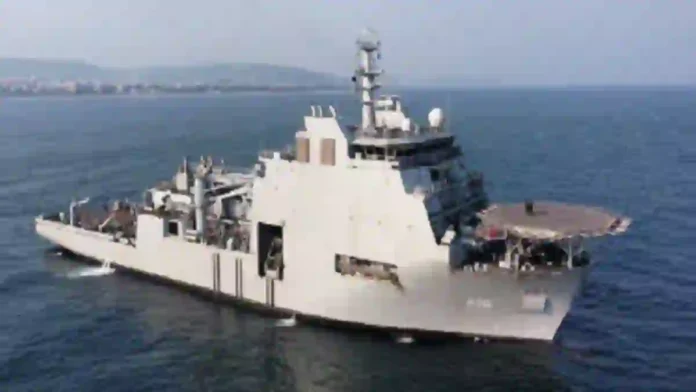India commissioned its first indigenously built Diving Support Vessel (DSV), INS Nistar, on July 18, 2025, at the Naval Dockyard in Visakhapatnam, marking a substantial achievement in the nation’s maritime capabilities and self-reliance. INS Nistar—meaning “rescue” or “salvation” in Sanskrit—was wholly designed and constructed by Hindustan Shipyard Limited (HSL), with more than 80% of its components sourced from Indian suppliers and active involvement from approximately 120 micro, small, and medium enterprises (MSMEs).
This aligns with India’s ‘Make in India’ initiative for the defence sector, aiming to boost indigenous technology and domestic manufacturing.
Read- How Akash Prime Strengthens India’s High-Altitude Air Defence, Maj Gen Rajan Kochar Explains
INS Nistar carries the legacy of an earlier vessel of the same name, commissioned in 1971, which played a critical role in the Indo-Pakistan War by identifying the sunken Pakistani submarine Ghazi near Visakhapatnam. The previous Nistar was decommissioned in 1989, and the new vessel now significantly expands on those capabilities.
INS Nistar is 120 meters long and displaces around 10,500 tons, making it a major addition to the Indian Navy’s fleet. It is technologically advanced, featuring:
Advanced saturation diving systems for prolonged and deep-sea diving operations
Submarine rescue capabilities, including functioning as the “mother ship” for Deep Submergence Rescue Vessels (DSRV), which can locate and evacuate crew from distressed submarines at great depths
Dynamic Positioning System (DPS) for precise station-keeping during complex underwater tasks
Side-scan sonar for seabed mapping and search operations
Endurance of over 60 days at sea and capacity to support helicopter operations
A 15-ton subsea crane for underwater recovery
Comprehensive medical facilities: operating theatre, intensive care unit, eight-bed hospital, and hyperbaric medical chamber for treating diving-related casualties
Read- Anadrone Systems: Pioneering Indigenous Aerial Target Systems For Atmanirbhar Bharat
Read- India Successfully Test-Fires Nuke Capable Agni-1 Ballistic Missiles From Integrated Test Range
Admiral Dinesh K Tripathi, Chief of Naval Staff, highlighted that only a select few navies globally possess such advanced submarine rescue capabilities—and even fewer can develop them indigenously. The commissioning of INS Nistar demonstrates India’s emergence as a key provider of submarine rescue in the region and supports its strategic objective of being a net security provider in the Indian Ocean.
The vessel’s addition strengthens the Indian Navy’s ability to execute deep-sea rescue, salvage, and support operations for itself and potentially for friendly nations, supporting India’s SAGAR (Security and Growth for All in the Region) vision.
Minister of State for Defence Sanjay Seth underscored that Nistar’s commissioning signifies a shift from India being a major defence importer to an exporter, with defence exports reaching over ₹23,622 crore and a target of ₹50,000 crore. Nistar’s successful indigenous development is a milestone for the country’s maritime and defence industries, further supporting India’s ambitions to become the world’s third-largest economy.
INS Nistar is now part of the Eastern Naval Command, significantly boosting India’s operational readiness for submarine rescue and complex underwater missions in the Indian Ocean and beyond.
Based On A PTI Report
Agencies




